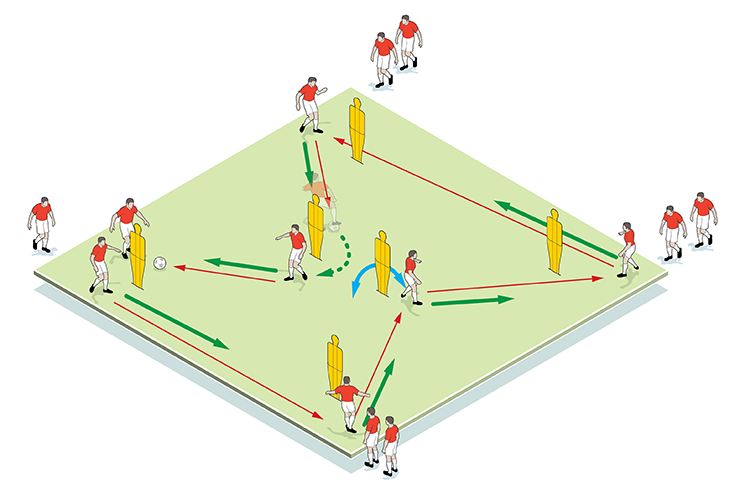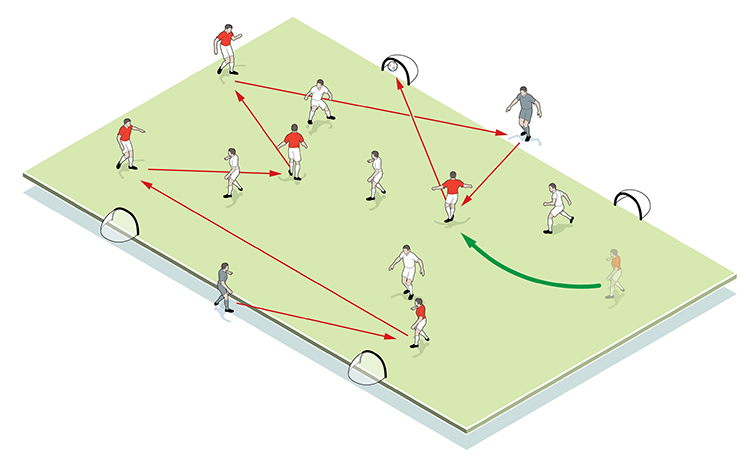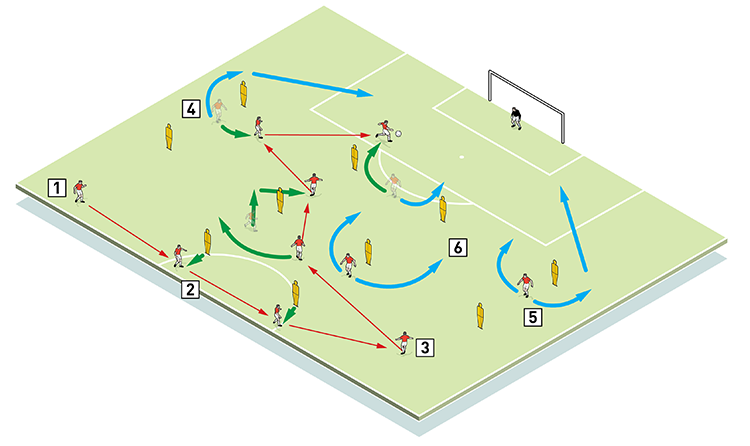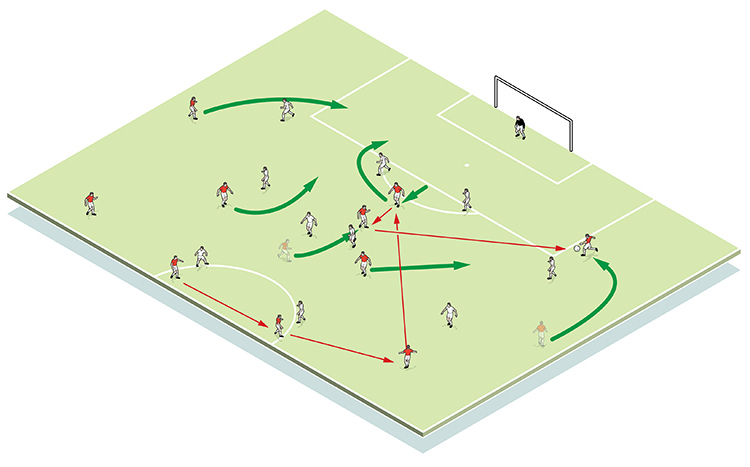Passing between and through the lines
If your team is set up to pass the ball, use this session to practise passing through and around the lines of defence. It focuses on keeping the ball on the floor, with players encouraged to find positive blind side angles of attack.

| Area | Up to half-pitch |
| Equipment | Balls, cones, mini-goals, goals |
| No. of Players | Up to 11v10 |
| Session Time | Passing in team shape 20mins, Target players game 20mins, Through the lines 30mins |
Particularly when playing at home, the problem of teams coming to sit in and defend can be a very real one. When at Luton Town, we perfected a method of countering this by making the pitch big, giving my team options in attack by pulling the opposition out of holes in order to penetrate through or around them.
This attacking session, therefore, is about playing through and around the lines of defence. It focuses on keeping the ball on the floor, with players encouraged to find positive blind side angles of attack.
It’s vital to practise this if your team is set up to pass the ball. It can be used in measured build-ups or quick counter-attack situations, with players’ positioning, passing and receiving skills, and weight of pass, all crucial in determining the success of the session.
What do I get the players to do?
Passing in team shape
We begin, as shown (1), by passing anti-clockwise from the top left starting point, with the ball fed from one base to the next. Players on the mannequins must pull away or to the side.
Once mastered, we change direction, also utilising a different starting point. Quick changes are important, as is plenty of variation.
1

Target players game
Next we move on to a 30x18-yard area - 7v5 with the ball and 5v7 without (2). Play begins with a target man, who must use ‘team mates’ to thread the ball through to the other target man. There, it’s touched back for a player to fire into either mini-goal. The starting position of the outfield players must mirror a game situation, and target players are two-touch maximum.
2

Through the lines
This next practice, on a half-pitch, is three-touch – unopposed at first (3), but then either 10v10 (4), or 10v8 in favour of attackers if wanting to force an overload. The start point forces full-backs to play to centre-backs, and as the attacking play builds, movement of players must be away from or in between mannequins, with a decisive pass or cross into the box to finish.
3

2. The centre-backs move it across the backline to the other side
3. A key pass is made into the central midfielder
4. The ball is slipped to the attacker who goes through on goal
5. Movement of offensive players must be away from or in between mannequins
6. Cover and decoy runs are vital because they keep defenders guessing
4

What are the key things to look out for technically/tactically?
Practices must be performed at match pace, with good timing of movement. Weight of pass must be measured, crisp and accurate, with players open and side-on to receive and play forward.
The final pass in front of or behind the striker is vital, as are attacking and cover runs of team mates. And all this should be done with the positions of the team mirroring game situations.
Throughout, we want to see players experimenting with different passing combinations. If they are ambitious and energetic, they will enjoy all that this session offers, because the practices are very game-related, and repeated success is achievable.
Editor's Picks
Attacking transitions
Deep runs in the final third
Using the goalkeeper in build-up play
Intensive boxes drill with goals
Penetrating the final third
Creating and finishing
My philosophy
Pressing initiation
Compact team movement
Coaches' Testimonials

Alan Pardew

Arsène Wenger

Brendan Rodgers

Carlos Carvalhal

José Mourinho

Jürgen Klopp

Pep Guardiola

Roy Hodgson

Sir Alex Ferguson

Steven Gerrard
Coaches' Testimonials

Gerald Kearney, Downtown Las Vegas Soccer Club

Paul Butler, Florida, USA

Rick Shields, Springboro, USA

Tony Green, Pierrefonds Titans, Quebec, Canada
Join the world's leading coaches and managers and discover for yourself one of the best kept secrets in coaching. No other training tool on the planet is written or read by the calibre of names you’ll find in Elite Soccer.
In a recent survey 92% of subscribers said Elite Soccer makes them more confident, 89% said it makes them a more effective coach and 91% said it makes them more inspired.
Get Monthly Inspiration
All the latest techniques and approaches
Since 2010 Elite Soccer has given subscribers exclusive insight into the training ground practices of the world’s best coaches. Published in partnership with the League Managers Association we have unparalleled access to the leading lights in the English leagues, as well as a host of international managers.
Elite Soccer exclusively features sessions written by the coaches themselves. There are no observed sessions and no sessions “in the style of”, just first-hand advice delivered direct to you from the coach.









